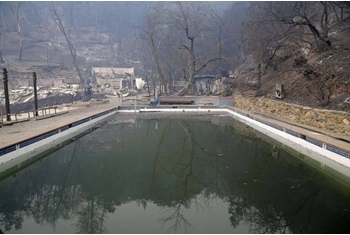 Role of Environmental Health Officers / authorised officers
Role of Environmental Health Officers / authorised officers
Environmental Health Officers can help to educate the community about appropriate remediation of contaminated swimming pools.
Health risks
After a bushfire, a swimming pool may contain debris including ash. This may affect the chemical balance of the water.
Swimming pools should either be emptied or kept chlorinated to prevent the water quality from deteriorating.
Contaminated swimming pools can be:
- a source of odours and bacteria
- a breeding place for mosquitoes
- a risk to people who use them.
If the pool can be emptied
The owner / operator will need to make an assessment as to whether it is safe to empty the pool.
Advice from a building consultant may be required.
Emptying a pool situated in an area with a high water table or in water–logged soils may put the pool walls under stress.
This could result in cracking or collapsing of the pool walls, or forcing the pool up out of the ground.
It will also be important that potentially contaminated pool water can be disposed of to a location where it will not:
- cause overflows in an already overloaded drainage system
- contaminate other water bodies.
If it is safe to empty the pool, then all water and residue should be removed.
Flush the plumbing pipes leading to the filters and replace filters or filter media.
Once emptied, the pool floor can be cleaned and sanitised using a 10 parts per million (ppm) chlorine solution.
Walls can be cleaned with a 10 per cent bicarbonate solution. Bicarbonate is also used to raise the pH.
Once completely cleaned, the pool can be refilled using scheme water, providing this has not also been compromised by the flood.
Disinfectant can be added to bring it up to the operating parameters.
Read more about the parameters in the Code of Practice for the Design, Operation, Management and Maintenance of Aquatic Facilities (PDF 95KB).
Where a pool cannot be emptied
Where the pool cannot be emptied, a trained technical operator will need to inspect the pool. The operator will determine an appropriate treatment to remove solids from the water, for example flocculation.
Depending on the amount and type of inundation, the water may need to be treated over several days. This will allow for all undissolved solids to descend to the floor of the pool ready for vacuuming.
Only when all the sand and sludge has been removed from the pool can effective chlorination commence. The pool and filters should be superchlorinated to 20mg/l (ppm) for up to 13 hours.
Depending on the nature and amount of contamination and the volume of the pool, the chemical treatment process and chlorination of the pool may take up to 1 week to complete.
Once the pool water is visibly clean, the pool motor and filter(s) may then be used to operate at the required chemical levels (for example chlorine, pH, bromine, cyanuric acid level).
Operators should determine the time required for a complete filtration cycle.
It should be noted that 4 complete cycles of the pool water are required to achieve 98 per cent filtration of pool water.
Further information
Key contact
Email swimmingpools@health.wa.gov.au for swimming pool related queries.